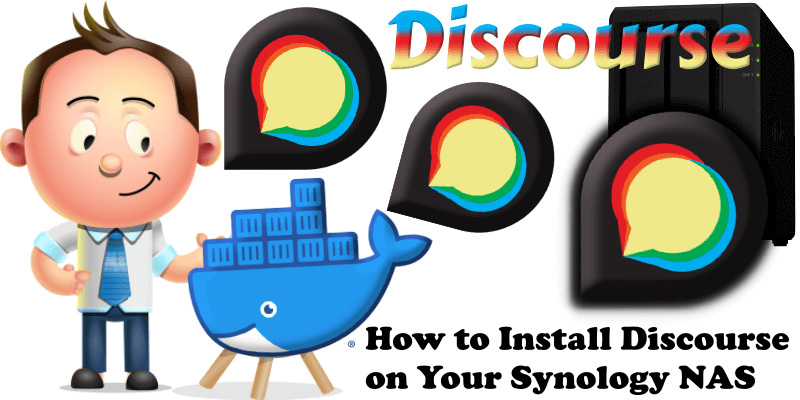
Discourse is an open source Internet forum system. Features include threading, categorization and tagging of discussions, configurable access control, live updates, expanding link previews, infinite scrolling, and real-time notifications. It is customizable via its plugin architecture and its theming system. Use it as a mailing list, discussion forum, long-form chat room, and more! In this step by step guide I will show you how to install Discourse on your Synology NAS using Docker and Portainer.
STEP 1
Please Support My work by Making a Donation.
STEP 2
Install Portainer using my step by step guide. If you already have Portainer installed on your Synology NAS, skip this STEP. Attention: Make sure you have installed the latest Portainer version.
STEP 3
Make sure you have a synology.me Wildcard Certificate. Follow my guide to get a Wildcard Certificate. If you already have a synology.me Wildcard certificate, skip this STEP.
STEP 4
Go to Control Panel / Login Portal / Advanced Tab / click Reverse Proxy. Follow the instructions in the image below.
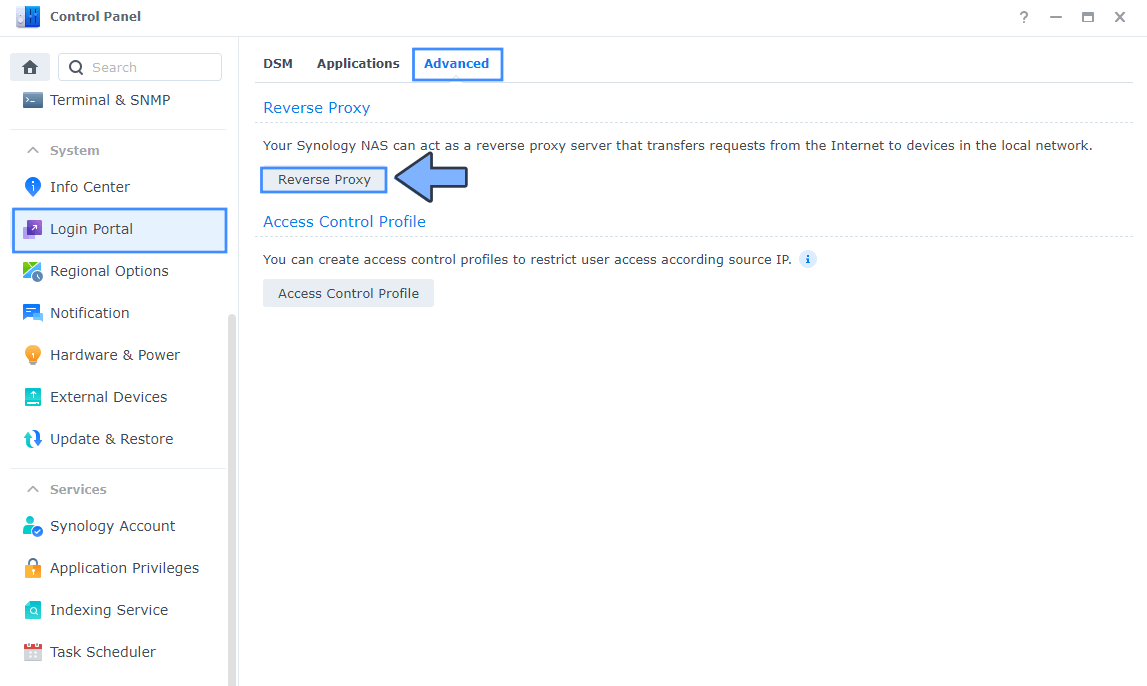
STEP 5
Now click the “Create” button. Follow the instructions in the image below.
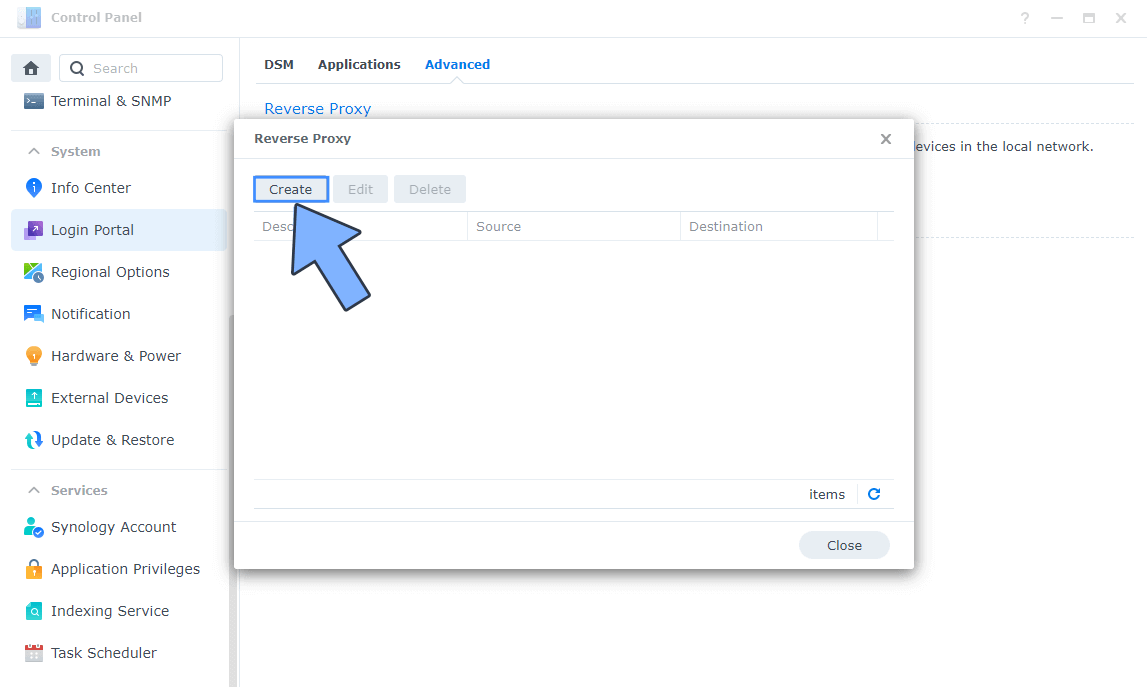
STEP 6
After you click the Create button, the window below will open. Follow the instructions in the image below.
On the General area, set the Reverse Proxy Name description: type in Discourse. After that, add the following instructions:
Source:
Protocol: HTTPS
Hostname: discourse.yourname.synology.me
Port: 443
Check Enable HSTS
Destination:
Protocol: HTTP
Hostname: localhost
Port: 2249

STEP 7
On the Reverse Proxy Rules click the Custom Header tab. Click Create and then, from the drop-down menu, click WebSocket. After you click on WebSocket, two Header Names and two Values will be automatically added. Click Save. Follow the instructions in the image below.

STEP 8
Go to Control Panel / Network / Connectivity tab/ Check Enable HTTP/2 then click Apply. Follow the instructions in the image below.
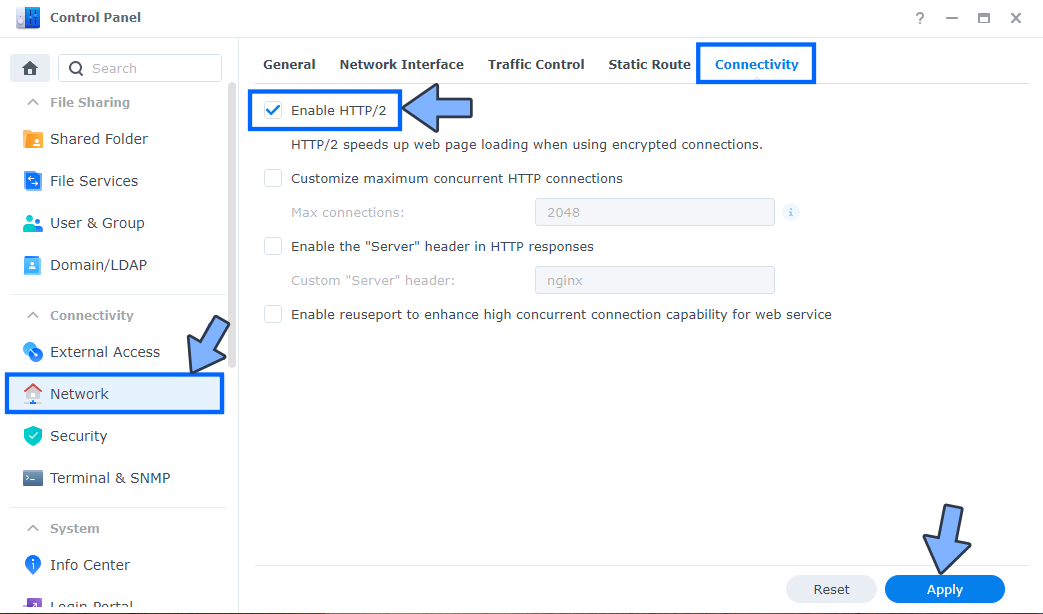
STEP 9
Go to Control Panel / Security / Advanced tab/ Check Enable HTTP Compression then click Apply. Follow the instructions in the image below.
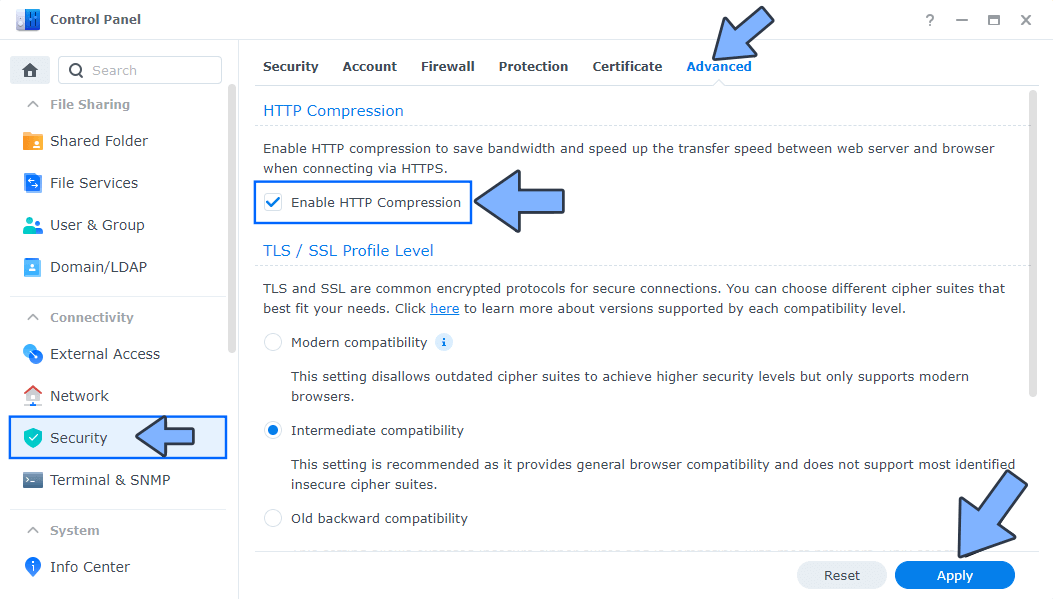
STEP 10
Go to File Station and open the docker folder. Inside the docker folder, create one new folder and name it discourse. Follow the instructions in the image below.
Note: Be careful to enter only lowercase, not uppercase letters.

STEP 11
Now create four new folders inside the discourse folder that you created at STEP 10 and name them data, db, redis, sidekiq. Follow the instructions in the image below.
Note: Be careful to enter only lowercase, not uppercase letters.
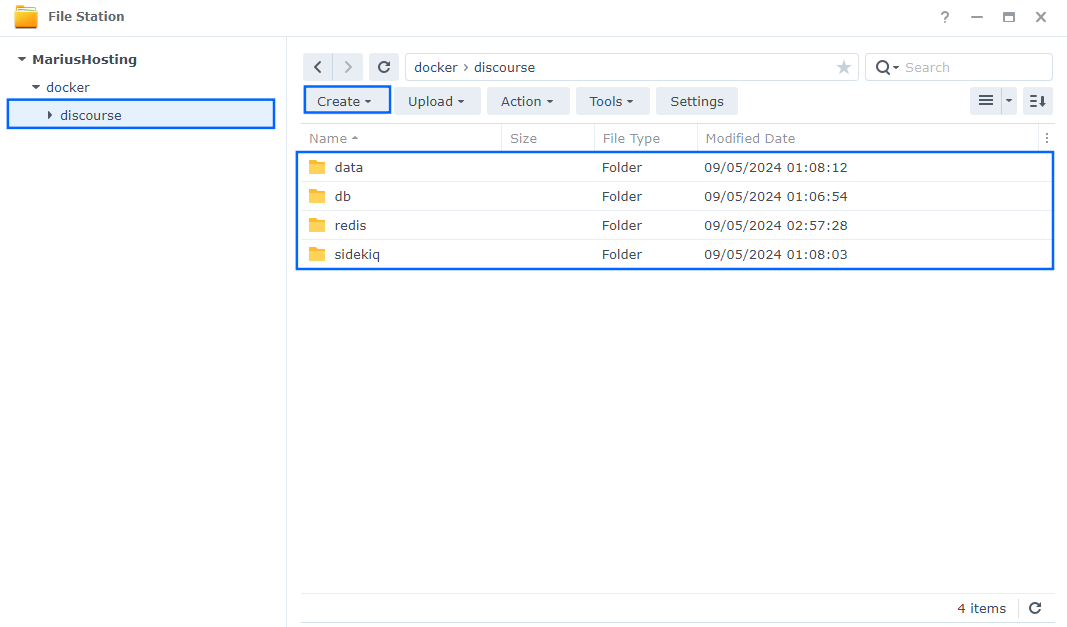
STEP 12
Right click on the discourse folder that you have previously created at STEP 11 then click Properties. Follow the instructions in the image below.
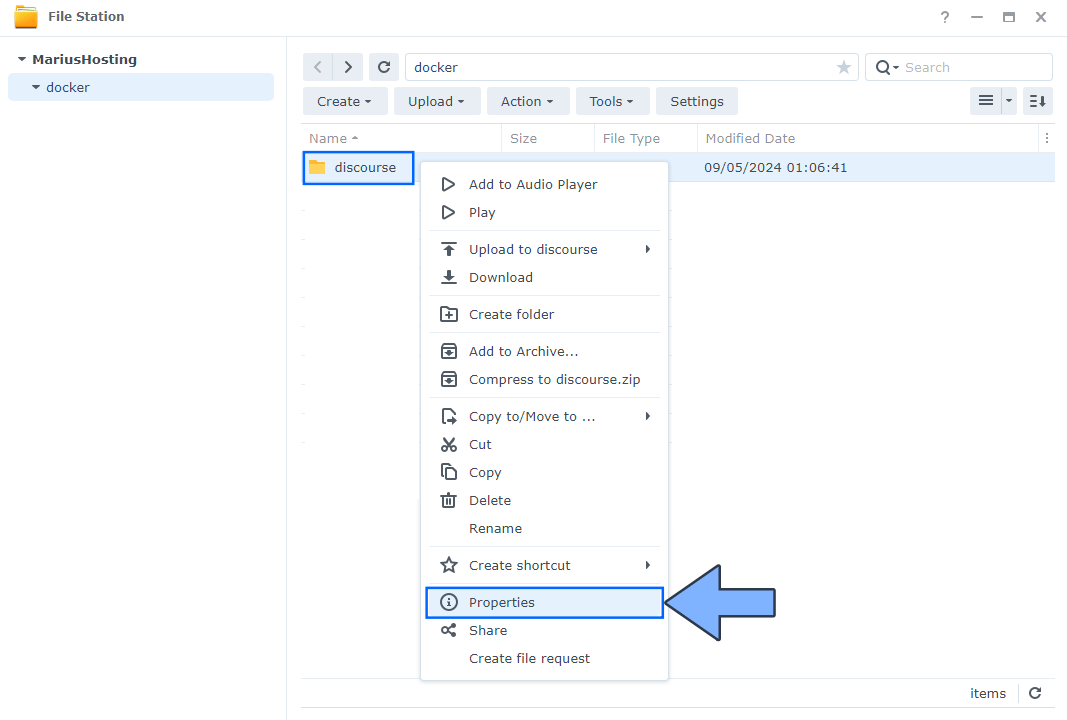
STEP 13
Go to the Permission tab, then click Advanced options. From the drop-down menu, choose “Make inherited permissions explicit“. Follow the instructions in the image below.
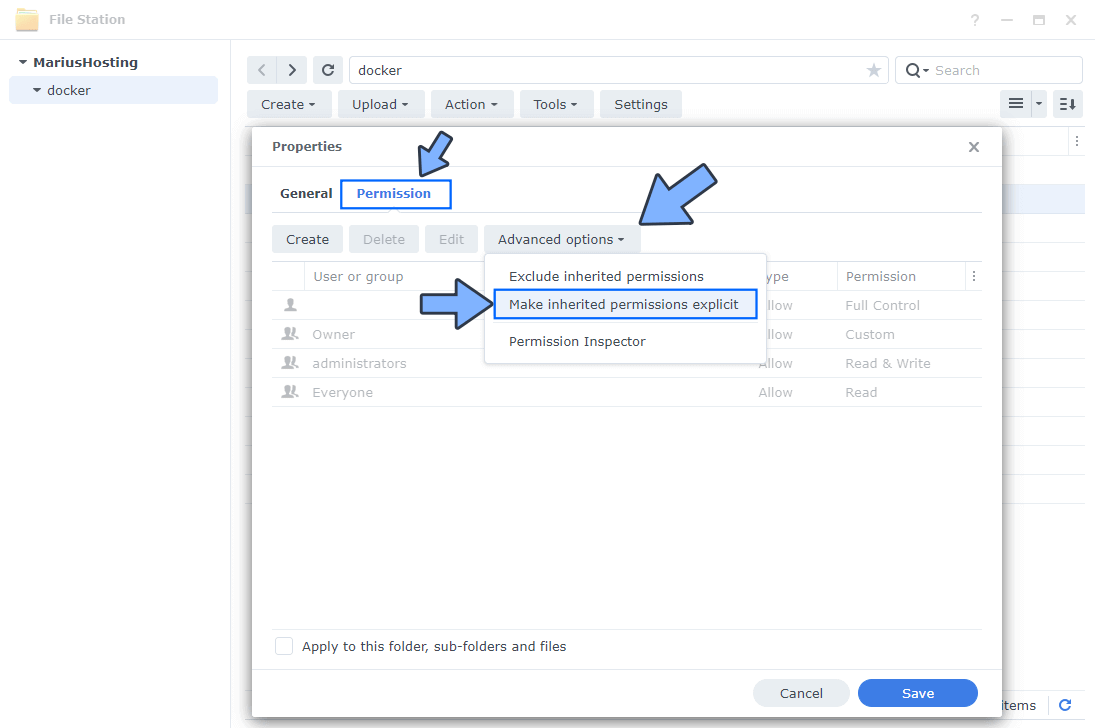
STEP 14
Select Everyone then click the Edit tab. Follow the instructions in the image below.
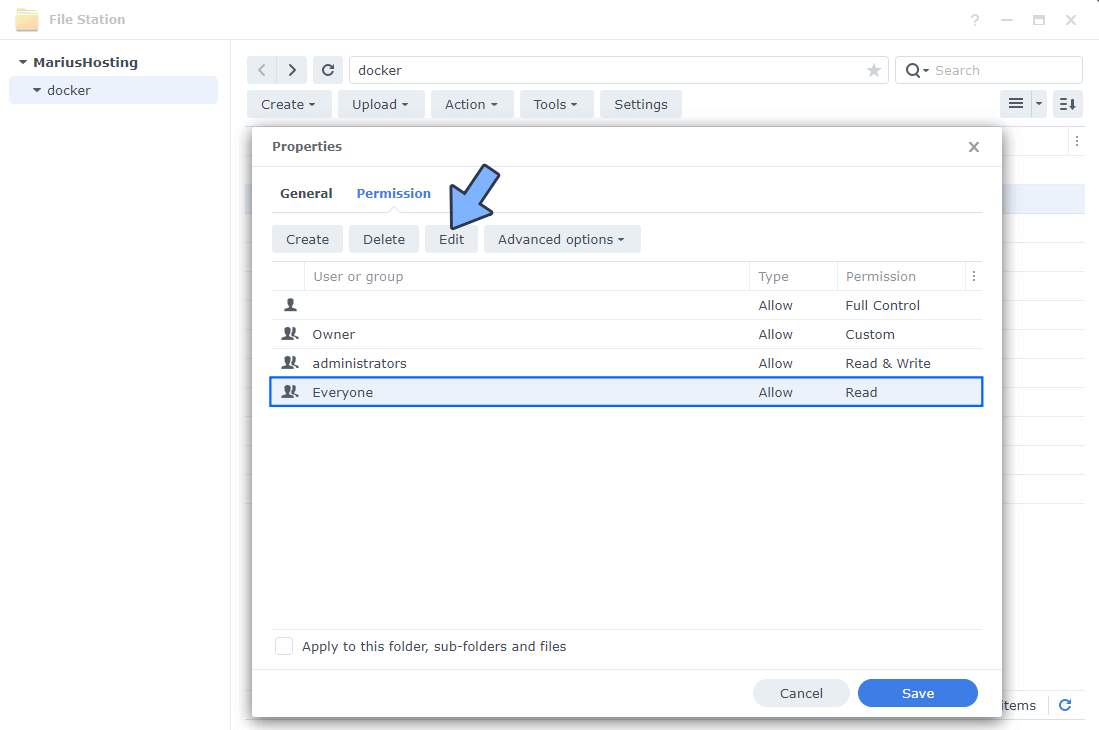
STEP 15
Check all Read and Write Permissions. Click Done. Follow the instructions in the image below.
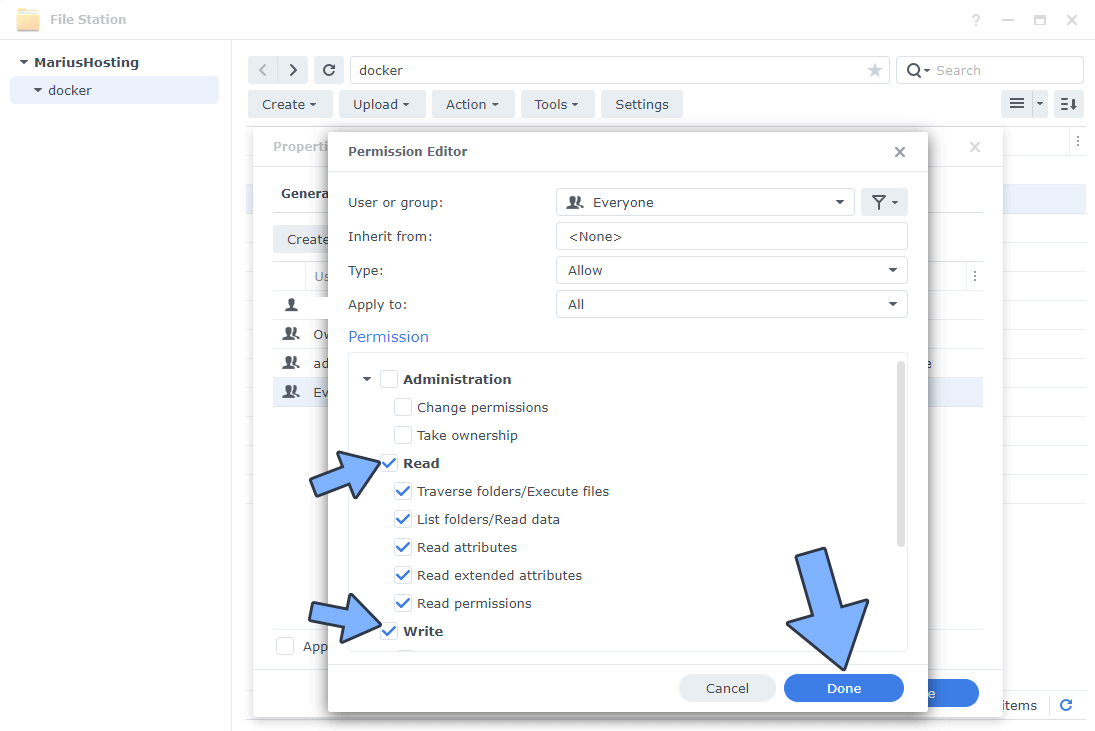
STEP 16
After you click Done on STEP 15, check “Apply to this folder, sub-folders and files“. Click Save. Follow the instructions in the image below.
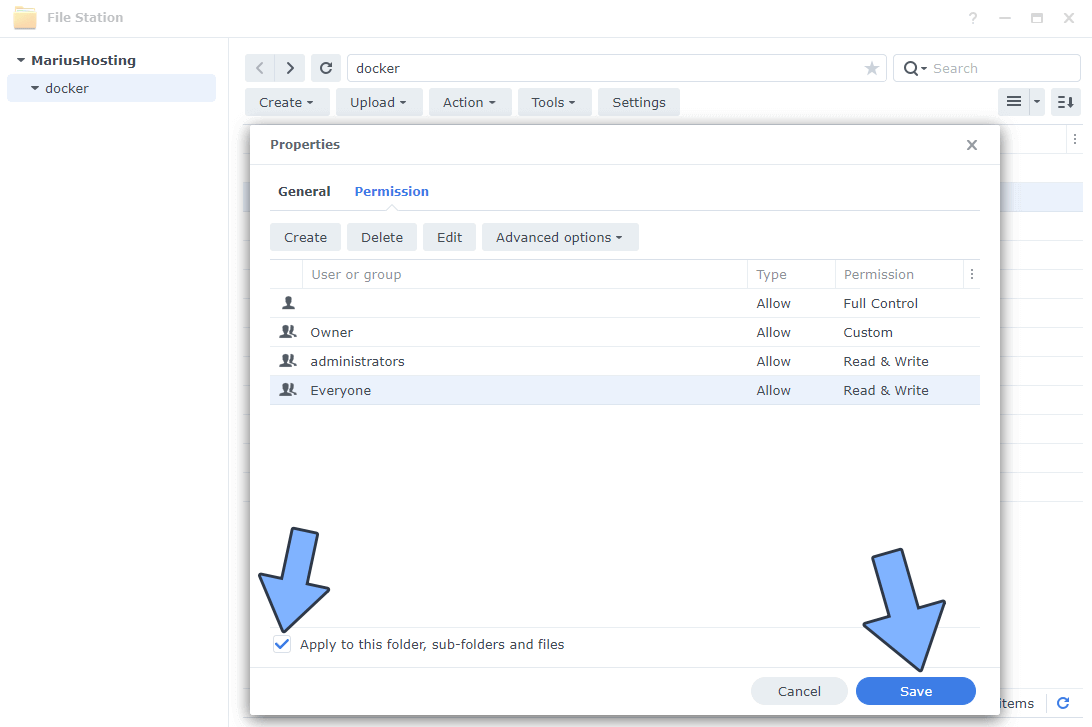
STEP 17
Follow my step by step guide on how to activate SMTP for your Gmail account. This step is mandatory. Note: If you don’t want to use the easiest way for SMTP with Google and you already have SMTP details from your own Mail Server, you can just skip this STEP and use your personalized email SMTP details instead.
STEP 18
Log into Portainer using your username and password. On the left sidebar in Portainer, click on Home then Live connect. Follow the instructions in the image below.
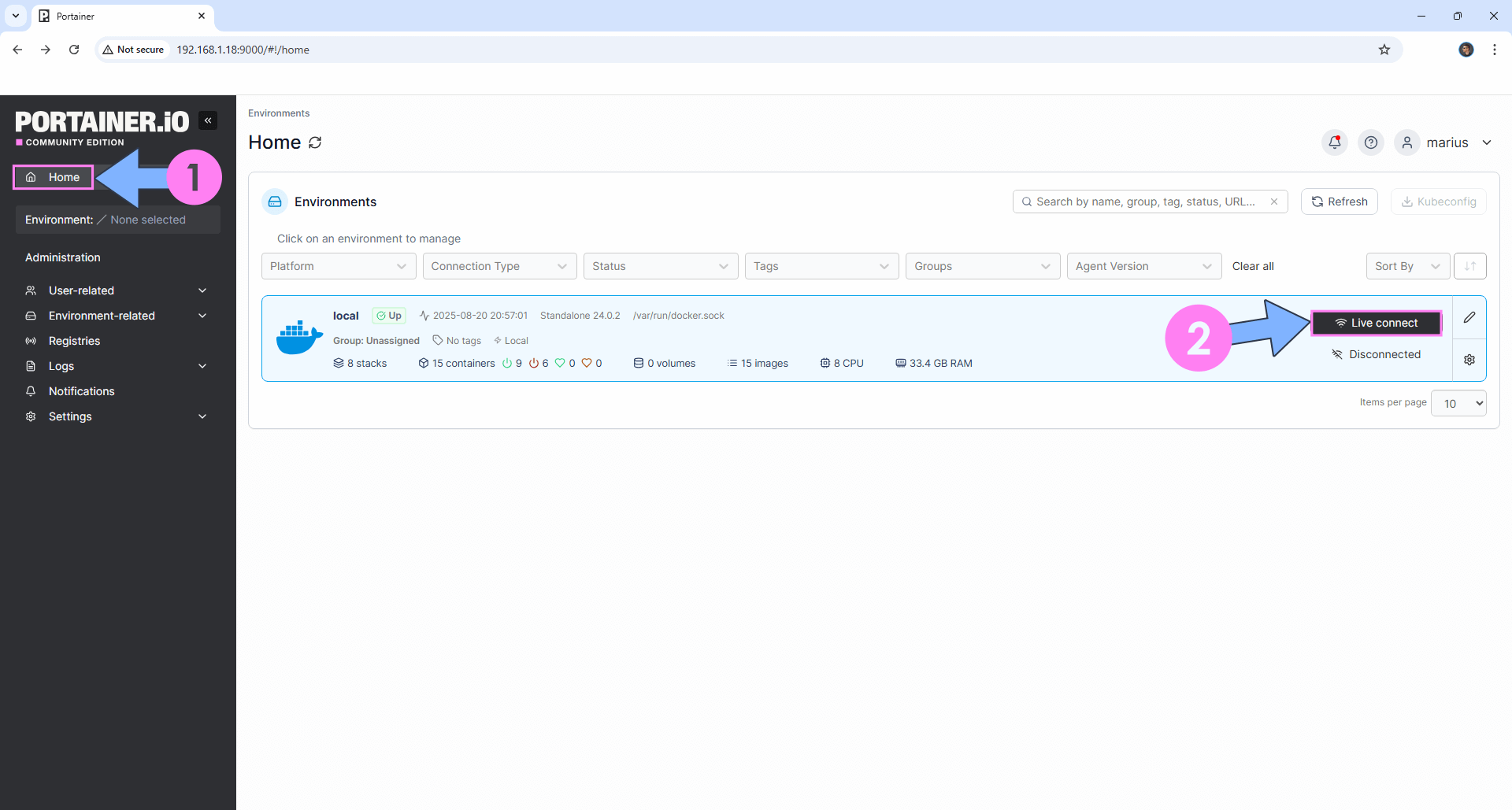
On the left sidebar in Portainer, click on Stacks then + Add stack. Follow the instructions in the image below.
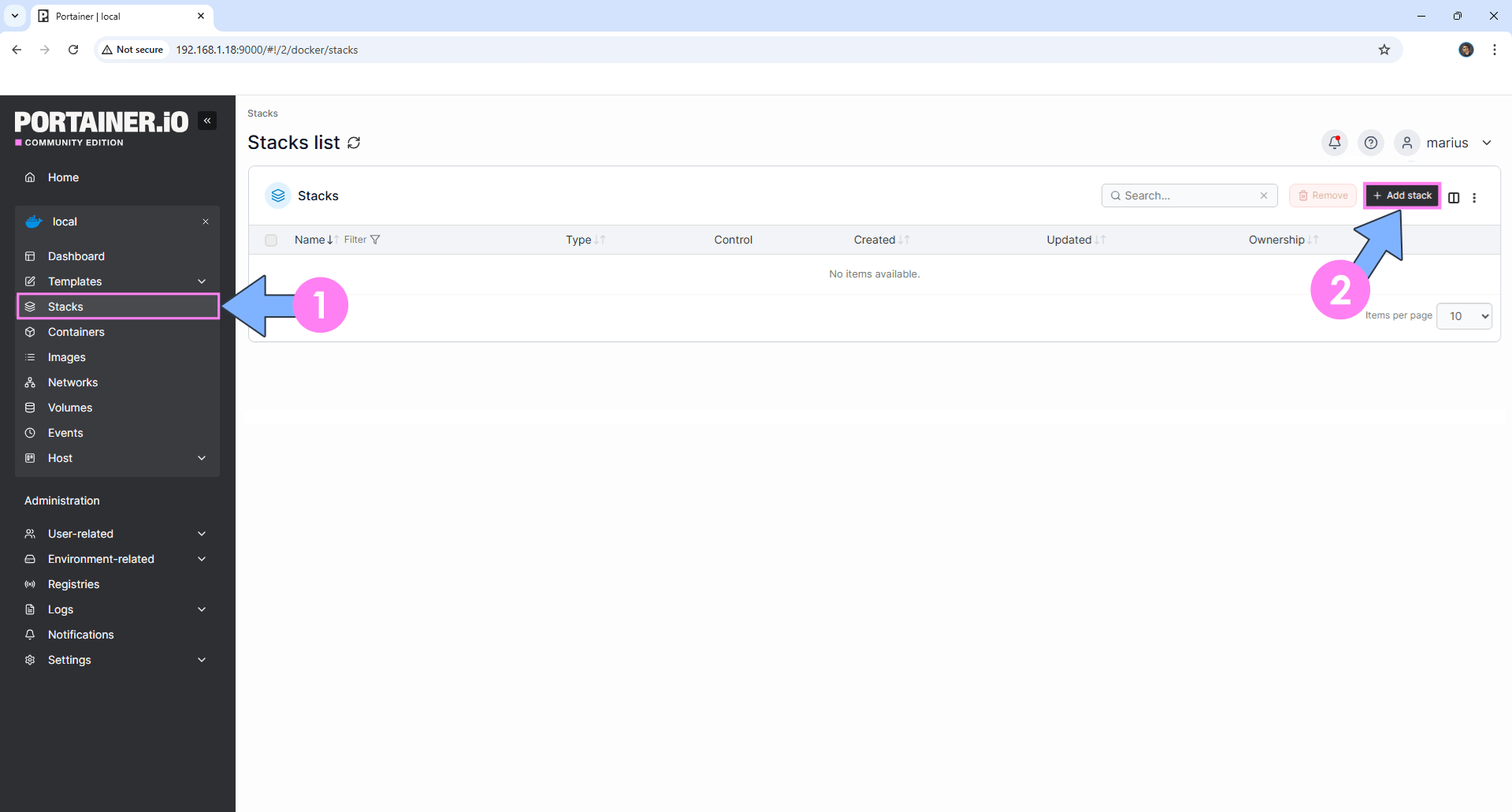
STEP 19
In the Name field type in discourse. Follow the instructions in the image below.
services:
postgresql:
image: pgvector/pgvector:pg16
container_name: Discourse-DB
hostname: postgresql
security_opt:
- no-new-privileges:true
healthcheck:
test: ["CMD", "pg_isready", "-q", "-d", "bitnami_discourse", "-U", "postgres"]
timeout: 45s
interval: 10s
retries: 10
volumes:
- /volume1/docker/discourse/db:/var/lib/postgresql/data:rw
environment:
POSTGRES_DB: bitnami_discourse
POSTGRES_USER: postgres
POSTGRES_PASSWORD: bitnami123
restart: on-failure:5
redis:
image: redis
container_name: Discourse-REDIS
command: redis-server --requirepass redispass
healthcheck:
test: ["CMD-SHELL", "redis-cli ping || exit 1"]
volumes:
- /volume1/docker/discourse/redis:/data:rw
environment:
TZ: Europe/Bucharest
restart: on-failure:5
discourse:
image: bitnamilegacy/discourse:3.5.0
container_name: Discourse
restart: on-failure:5
healthcheck:
test: timeout 10s bash -c ':> /dev/tcp/127.0.0.1/3000' || exit 1
interval: 10s
timeout: 5s
retries: 3
start_period: 90s
ports:
- 2249:3000
depends_on:
- postgresql
- redis
environment:
- DISCOURSE_USERNAME=marius1984 #Username should be a minimum of 10 carachters.
- DISCOURSE_PASSWORD=mariushosting10 #Password should be a minimum of 15 carachters.
- DISCOURSE_EMAIL=yourown@email
- DISCOURSE_ENV=production
- DISCOURSE_ENABLE_HTTPS=yes
- DISCOURSE_DATABASE_HOST=postgresql
- DISCOURSE_DATABASE_PORT_NUMBER=5432
- DISCOURSE_DATABASE_USER=postgres
- DISCOURSE_DATABASE_NAME=bitnami_discourse
- DISCOURSE_DATABASE_PASSWORD=bitnami123
- DISCOURSE_REDIS_HOST=redis
- DISCOURSE_REDIS_PORT_NUMBER=6379
- DISCOURSE_REDIS_PASSWORD=redispass
- POSTGRESQL_CLIENT_POSTGRES_USER=postgres
- POSTGRESQL_CLIENT_POSTGRES_PASSWORD=bitnami123
- POSTGRESQL_CLIENT_CREATE_DATABASE_NAME=bitnami_discourse
- POSTGRESQL_CLIENT_CREATE_DATABASE_EXTENSIONS=hstore,pg_trgm
- DISCOURSE_HOST=discourse.yourname.synology.me
- DISCOURSE_DEVELOPER_EMAILS=yourown@email
- DISCOURSE_SMTP_HOST=smtp.gmail.com
- DISCOURSE_SMTP_AUTH=login
- DISCOURSE_SMTP_PORT_NUMBER=587
- DISCOURSE_SMTP_USER=Your-own-gmail-address
- DISCOURSE_SMTP_PASSWORD=Your-own-app-password
- DISCOURSE_SMTP_PROTOCOL=tls
- BITNAMI_DEBUG=true
volumes:
- /volume1/docker/discourse/data:/bitnami/discourse:rw
sidekiq:
image: bitnamilegacy/discourse:3.5.0
container_name: Discourse-SIDEKIQ
depends_on:
- discourse
volumes:
- /volume1/docker/discourse/sidekiq:/bitnami/discourse:rw
command: /opt/bitnami/scripts/discourse-sidekiq/run.sh
environment:
- DISCOURSE_USERNAME=marius1984 #Username should be a minimum of 10 carachters.
- DISCOURSE_PASSWORD=mariushosting10 #Password should be a minimum of 15 carachters.
- DISCOURSE_HOST=discourse.yourname.synology.me
- DISCOURSE_ENABLE_HTTPS=yes
- DISCOURSE_ENV=production
- DISCOURSE_DATABASE_HOST=postgresql
- DISCOURSE_DATABASE_PORT_NUMBER=5432
- DISCOURSE_DATABASE_USER=postgres
- DISCOURSE_DATABASE_NAME=bitnami_discourse
- DISCOURSE_DATABASE_PASSWORD=bitnami123
- DISCOURSE_REDIS_HOST=redis
- DISCOURSE_REDIS_PORT_NUMBER=6379
- DISCOURSE_REDIS_PASSWORD=redispass
- DISCOURSE_DEVELOPER_EMAILS=yourown@email
- DISCOURSE_SMTP_HOST=smtp.gmail.com
- DISCOURSE_SMTP_AUTH=login
- DISCOURSE_SMTP_PORT_NUMBER=587
- DISCOURSE_SMTP_USER=Your-own-gmail-address
- DISCOURSE_SMTP_PASSWORD=Your-own-app-password
- DISCOURSE_SMTP_PROTOCOL=tls
- BITNAMI_DEBUG=true
Note: Before you paste the code above in the Web editor area below, change the value for TZ. (Select your current Time Zone from this list.)
Note: Before you paste the code above in the Web editor area below, change the value for DISCOURSE_USERNAME. Type in your own username. marius1984 is an example for a username.
Note: Before you paste the code above in the Web editor area below, change the value for DISCOURSE_PASSWORD. Type in your own password. mariushosting10 is an example for a password. You will need this password later at STEP 24.
Note: Before you paste the code above in the Web editor area below, change the value for DISCOURSE_EMAIL. Type in your own email address. You will need this email later at STEP 24.
Note: Before you paste the code above in the Web editor area below, change the value for DISCOURSE_HOST and type in your own synology.me DDNS without https:// at the beginning that you have previously created at STEP 6.
Note: Before you paste the code above in the Web editor area below, change the value for DISCOURSE_DEVELOPER_EMAILS. Type in your own email address. You will need this email address at STEP 24.
Note: Before you paste the code above in the Web editor area below, change the value for DISCOURSE_SMTP_USER and type in your own Gmail address. Refer to STEP 17.
Note: Before you paste the code above in the Web editor area below, change the value for DISCOURSE_SMTP_PASSWORD and type in your own Gmail app password. Refer to STEP 17.
Note: Before you paste the code above in the Web editor area below, change the value for DISCOURSE_HOST and type in your own synology.me DDNS without https:// at the beginning that you have previously created at STEP 6.
Note: Before you paste the code above in the Web editor area below, change the value for DISCOURSE_DEVELOPER_EMAILS. Type in your own email address. You will need this email address at STEP 24.
Note: Before you paste the code above in the Web editor area below, change the value for DISCOURSE_SMTP_USER and type in your own Gmail address. Refer to STEP 17.
Note: Before you paste the code above in the Web editor area below, change the value for DISCOURSE_SMTP_PASSWORD and type in your own Gmail app password. Refer to STEP 17.
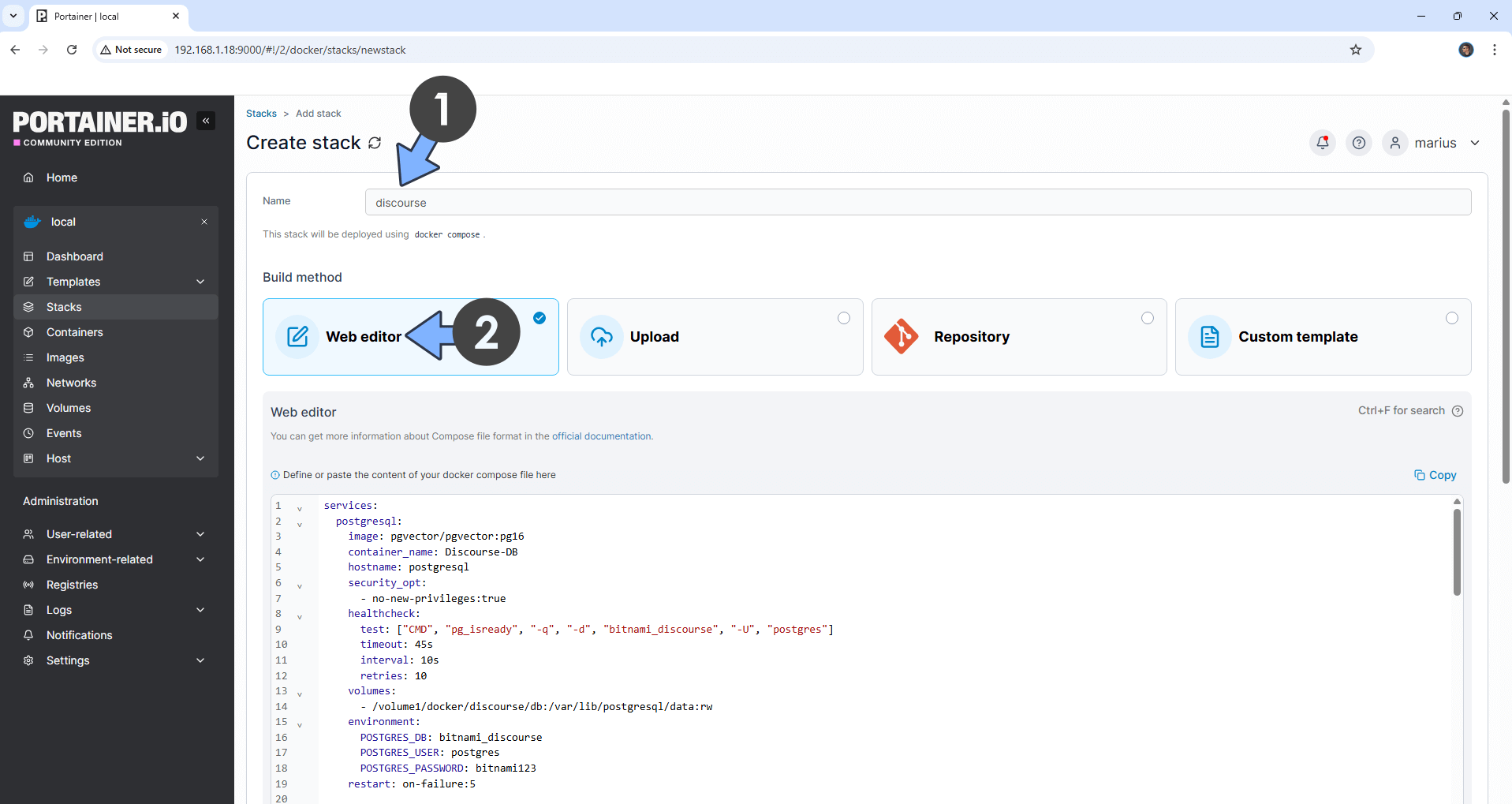
STEP 20
Scroll down on the page until you see a button named Deploy the stack. Click on it. Follow the instructions in the image below. The installation process can take up to a few minutes. It will depend on your Internet speed connection.
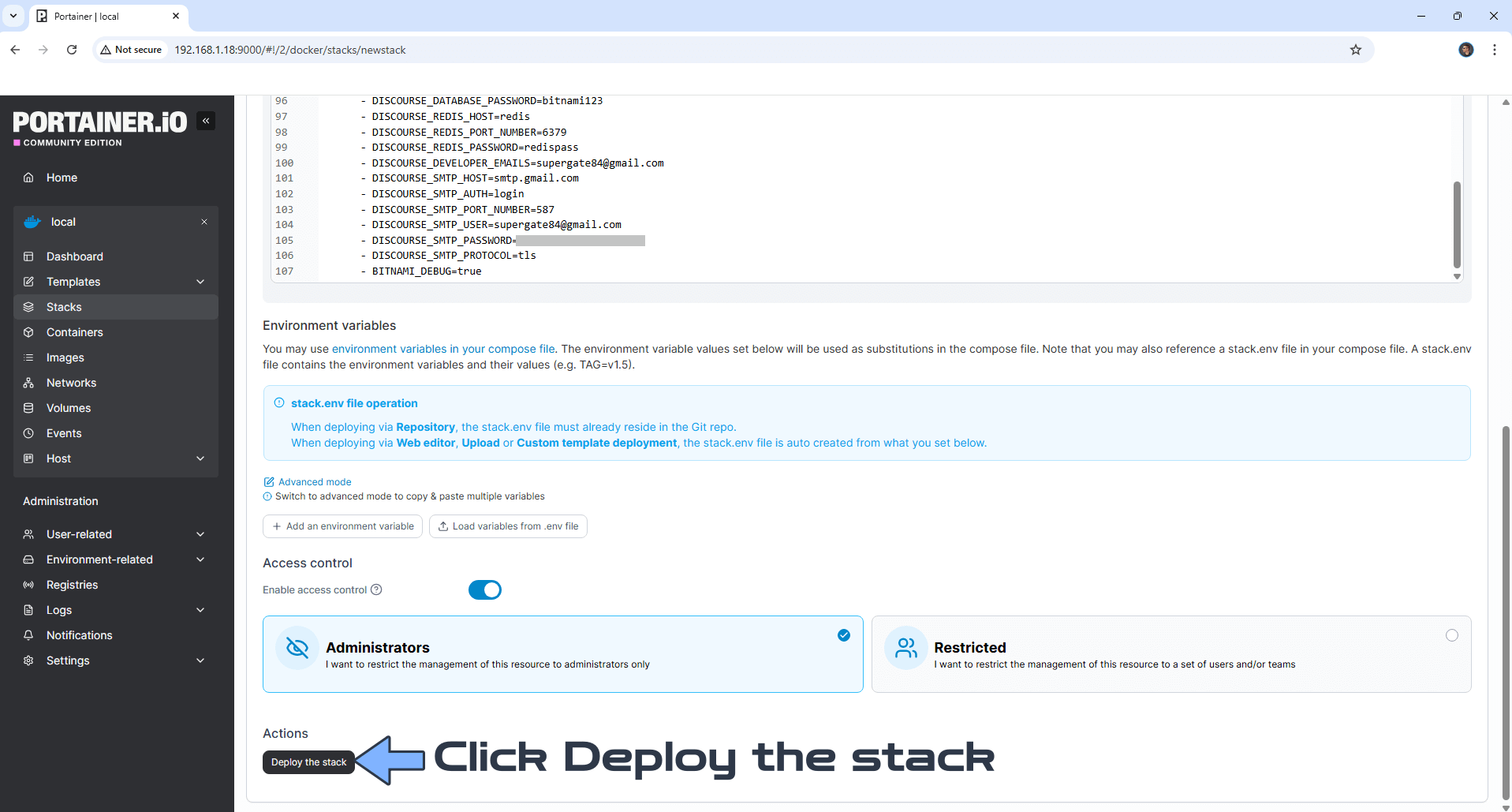
STEP 21
If everything goes right, you will see the following message at the top right of your screen: “Success Stack successfully deployed“.
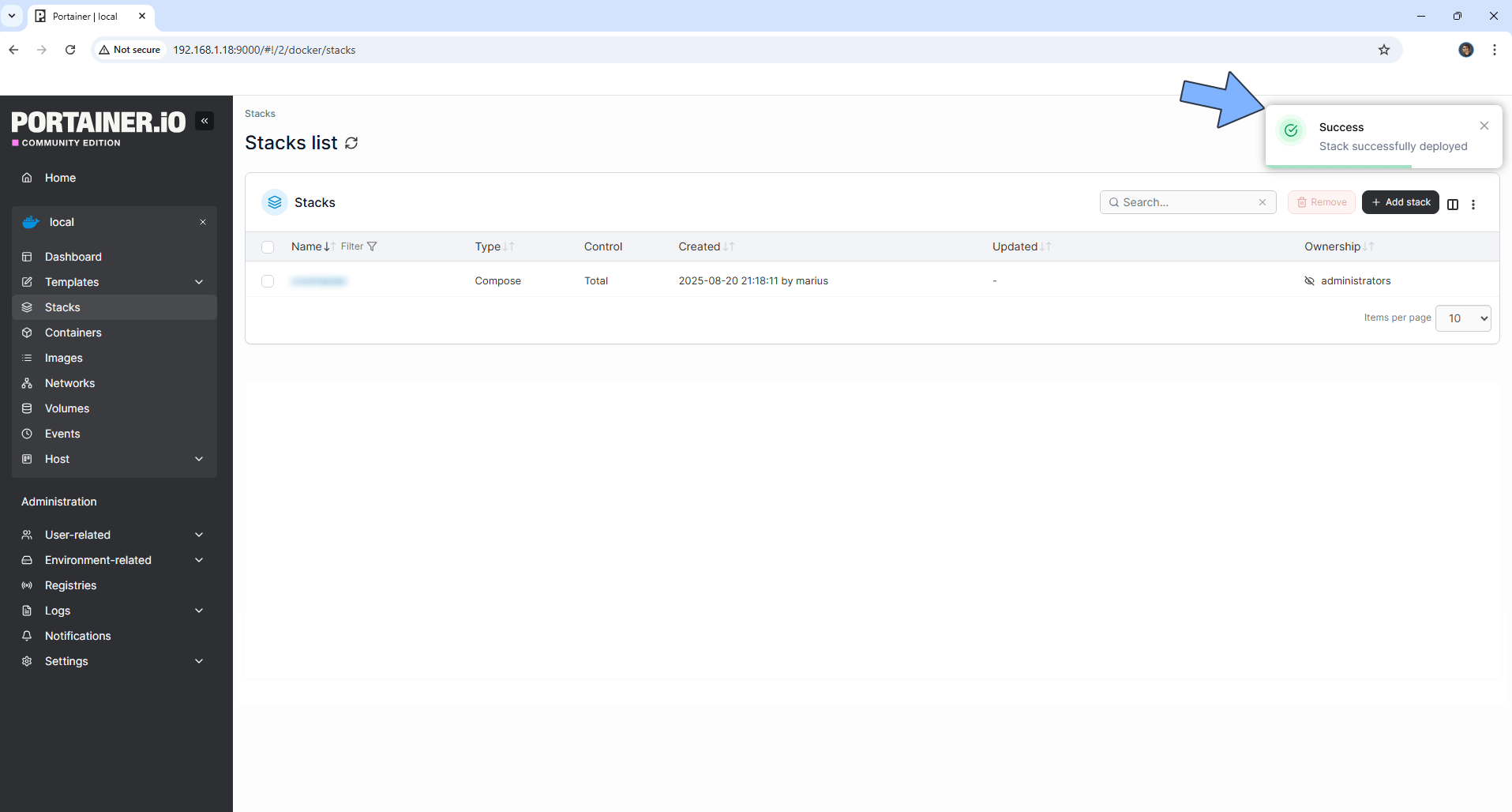
STEP 22
🟢Please Support My work by Making a Donation. Almost 99,9% of the people that install something using my guides forget to support my work, or just ignore STEP 1. I’ve been very honest about this aspect of my work since the beginning: I don’t run any ADS, I don’t require subscriptions, paid or otherwise, I don’t collect IPs, emails, and I don’t have any referral links from Amazon or other merchants. I also don’t have any POP-UPs or COOKIES. I have repeatedly been told over the years how much I have contributed to the community. It’s something I love doing and have been honest about my passion since the beginning. But I also Need The Community to Support me Back to be able to continue doing this work.
STEP 23
Please wait approximately 10-12 minutes for the installation to be completed or you will get a blank error page if you try to connect too soon. Now open your browser and type in your HTTPS/SSL certificate like this https://discourse.yourname.synology.me that you have previously created at STEP 6. In my case it’s https://discourse.mariushosting.synology.me If everything goes right, you will see the main Discourse login page. Click Log in. Follow the instructions in the image below.
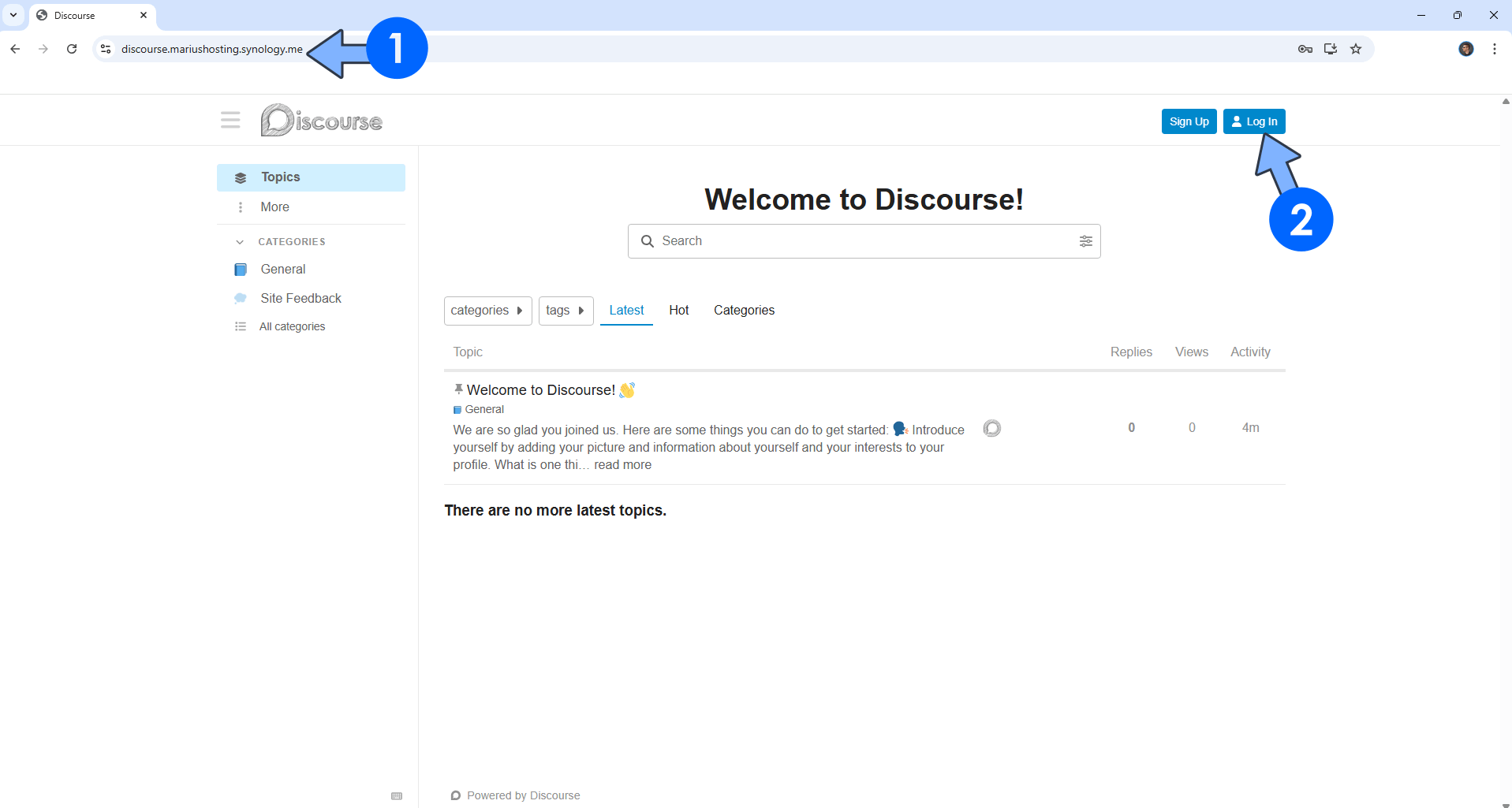
STEP 24
A new pop up window will open. Type in your own Email Address (DISCOURSE_EMAIL) and your own Password (DISCOURSE_PASSWORD) that you have previously added at STEP 19, then click Log in. Follow the instructions in the image below.
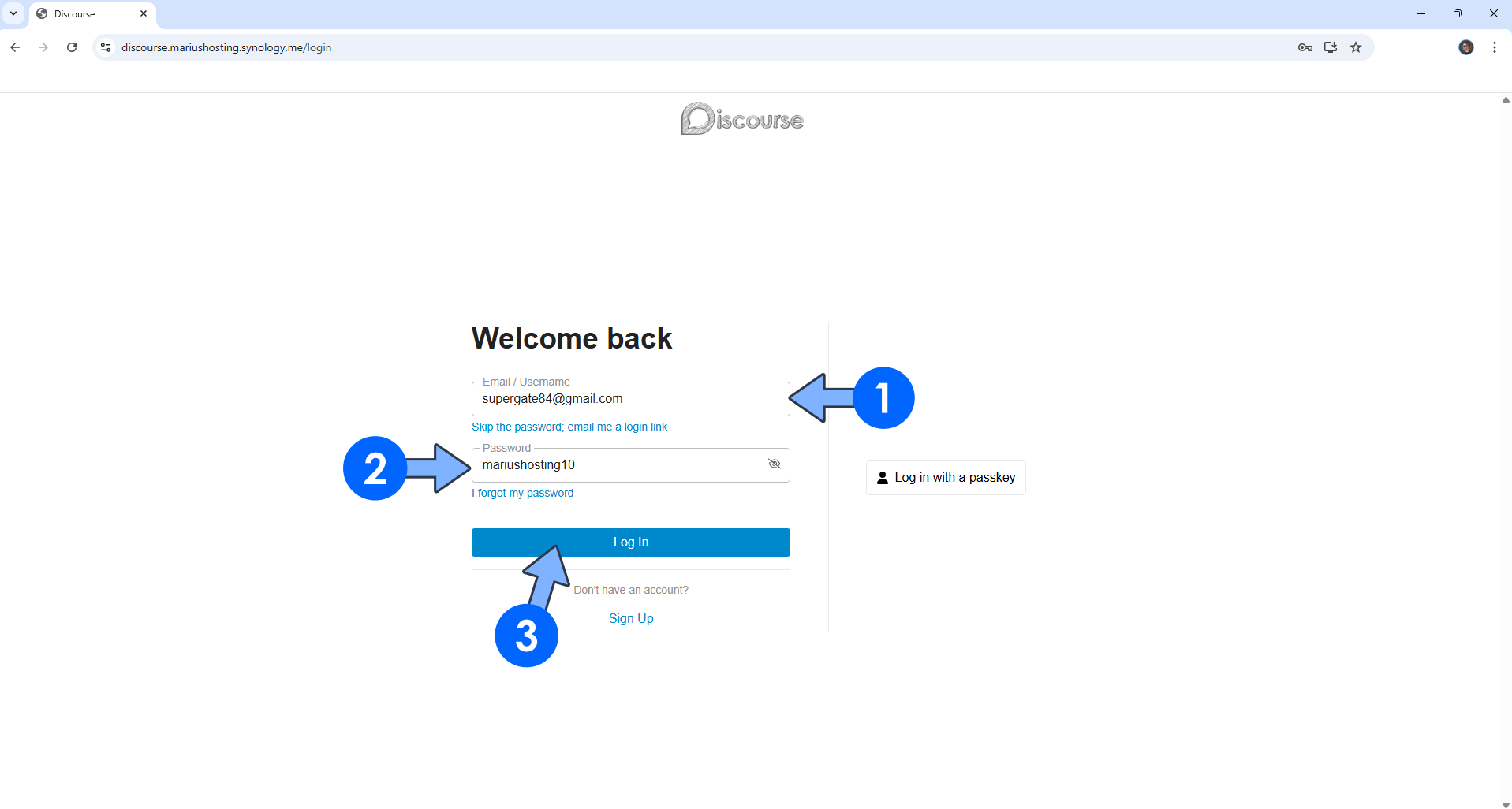
STEP 25
On the left Discourse sidebar, click Admin. Follow the instructions in the image below.
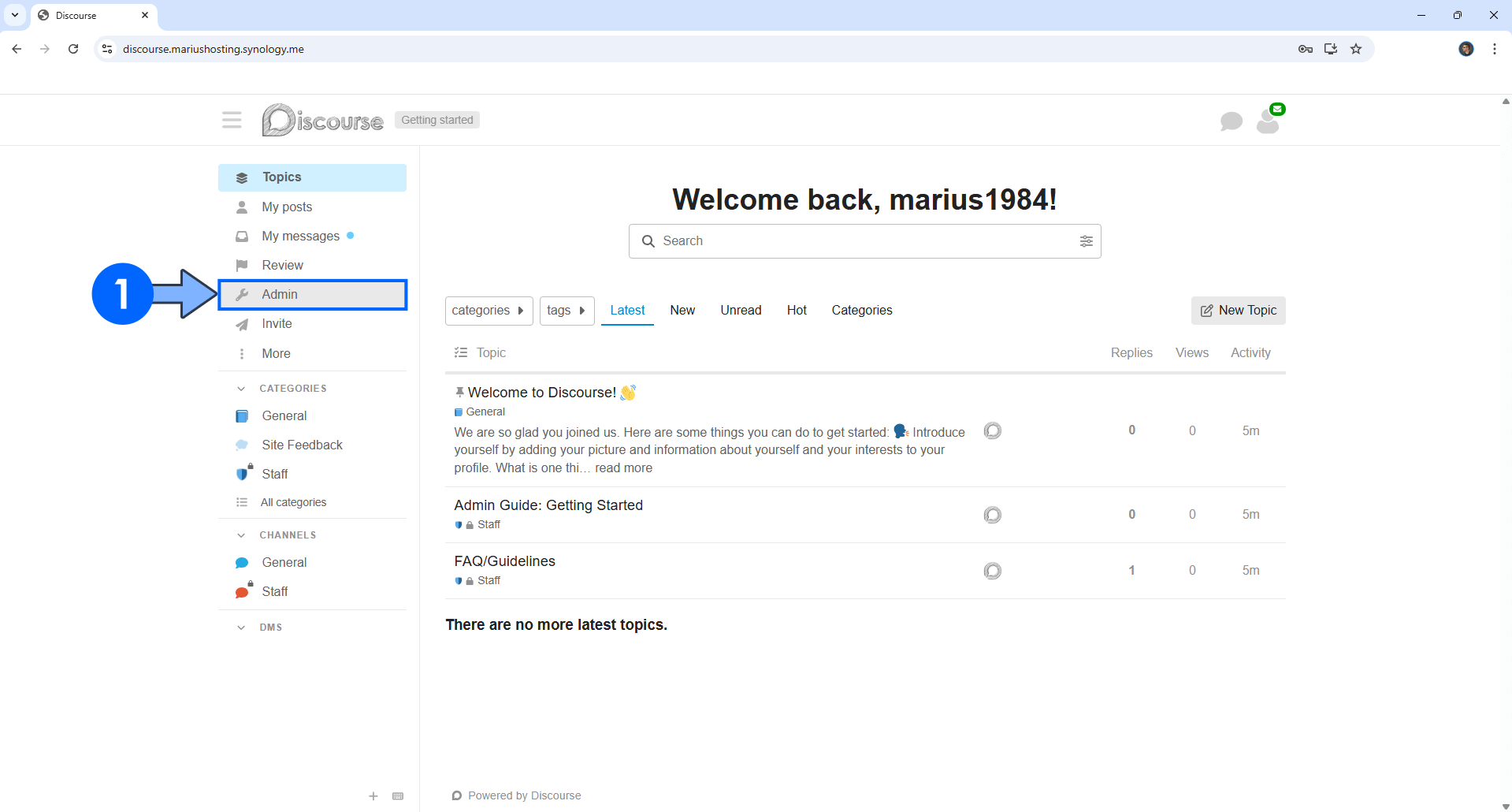
STEP 26
Click Security. Check the Force HTTPS option, then confirm it. Follow the instructions in the image below.
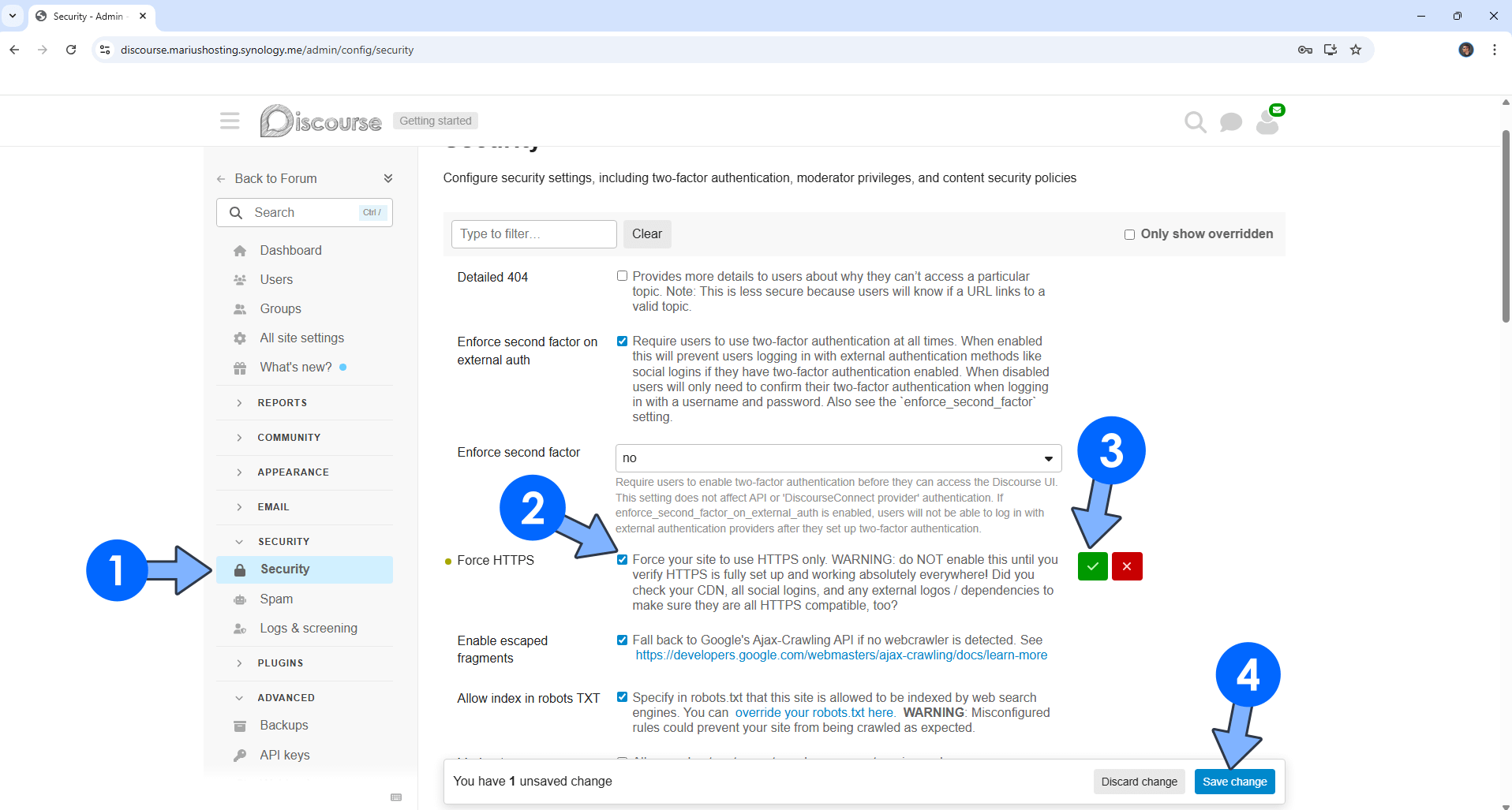
STEP 27
Your Discourse forum at a glance!
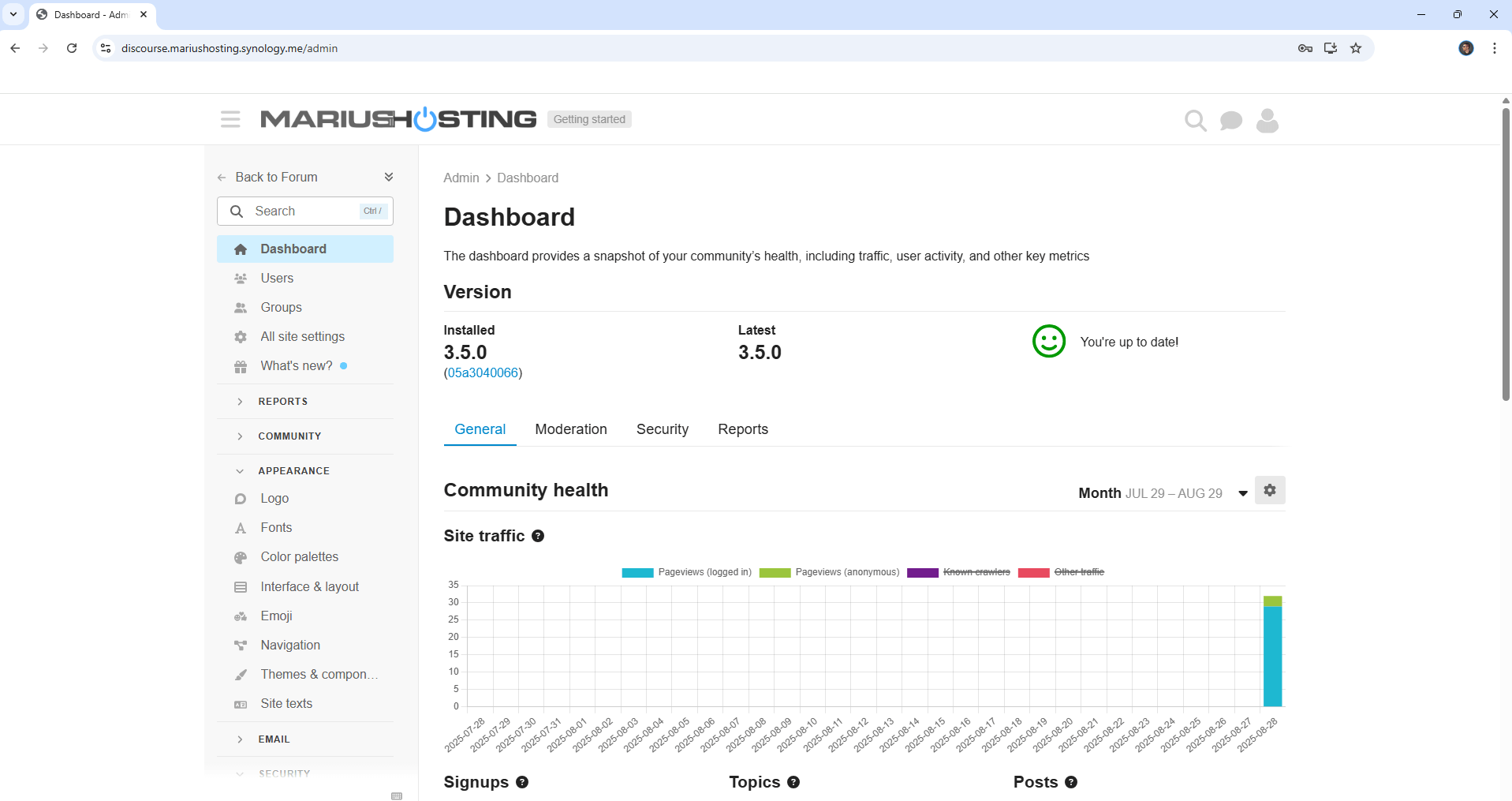
Add your first post!
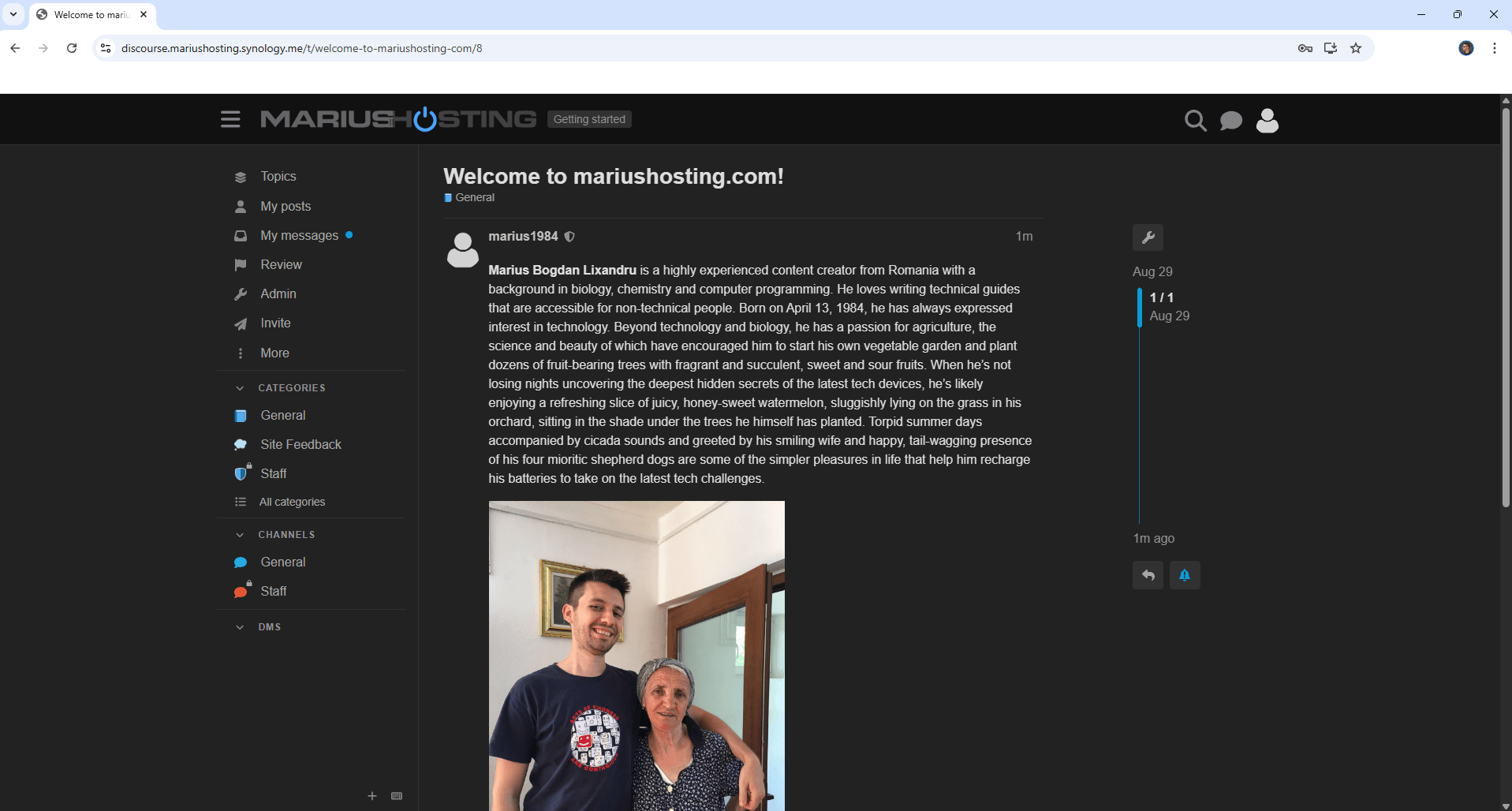
Enjoy Discourse!
If you encounter issues by using this container, make sure to check out the Common Docker issues article.
Note: Can I run Docker on my Synology NAS? See the supported models.
Note: How to Back Up Docker Containers on your Synology NAS.
Note: Find out how to update the Discourse container with the latest image.
Note: How to Free Disk Space on Your NAS if You Run Docker.
Note: How to Schedule Start & Stop For Docker Containers.
Note: How to Activate Email Notifications.
Note: How to Add Access Control Profile on Your NAS.
Note: How to Change Docker Containers Restart Policy.
Note: How to Use Docker Containers With VPN.
Note: Convert Docker Run Into Docker Compose.
Note: How to Clean Docker.
Note: How to Clean Docker Automatically.
Note: Best Practices When Using Docker and DDNS.
Note: Some Docker Containers Need WebSocket.
Note: Find out the Best NAS Models For Docker.
Note: Activate Gmail SMTP For Docker Containers.
This post was updated on Thursday / October 2nd, 2025 at 1:59 PM
